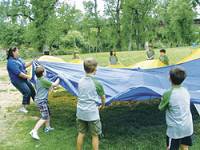Hiking the trails to see the wildlife, making arts and crafts items and playing many games, about a dozen children had a great time at Jacob Myers Park this past week in the annual Outdoor Adventure Camp arranged by Riverbank Recreation Department.
Friends of the Park member Scott McRitchie led a nature walk on Monday, Laurie Larson of the Great Valley Museum brought caged animals like snakes and a blue-tongued skink for examination on Tuesday and a Corps of Engineers representative talked about water safety on another day.
What was the children's favorite experience? Definitely the animals from the Modesto museum's traveling exhibit, said several.
"The funniest bit was the skink with the blue tongue," said Peter Pacheco.
"I enjoyed writing thank you letters to Mr. McRitchie," said another girl attending the camp.
"I liked all the crafts," added Robert Pacheco.
"The kids and the hike," were the favorites for recreation aide Juanita Argumedo. "The only disappointing thing is we had to stay away from the river this year because it's running so high and fast. We're used to making boats and floating them in the shallows."
One spirited game at the adventure camp involved a blue and yellow parachute with a beach ball rolled into in the center which the children contrived to direct into a pocket at each end by pulling and jerking on the parachute.
A favorite crafts activity was the making of what is called "God's Eye." It requires winding colored yarn around the center of crossed sticks to form a pattern resembling an all-seeing eye.
A botany major in college and later an agricultural consultant, McRitchie described the walk to see the park's flora and fauna in some detail.
He explained the difference between trees like the Valley oak that spreads its seeds by dropping acorns and the cottonwood that grow along the water's edge and disperses its seeds in clumps of cotton carried by the wind.
On their hike, the children saw squirrels, hawks and herons and traces of earth burrowing moles and gophers. Moles are meat eaters, McRitchie noted, but gophers are vegetarian and live on roots growing below the ground.
The hikers came upon coyote droppings and learned raccoons and possums are both nocturnal animals but the latter animal is more of a scavenger in its eating habits.
McRitchie noted the park's upper trail has more of a dry desert ecology whereas the lower trail along the river has a lot more flowers and waterside plants such as gourds.
He showed his followers "oak galls" or swellings on a tree trunk where a tiny wasp burrowed below the bark to lay its eggs. He talked about a local endangered species, the elderberry beetle, which must be protected during development. Laying their eggs on elderberry bushes, they flourish in the area just north of the Stanislaus River. Potential developers must obtain a biologist's report and take care to avoid the beetles' habitat.
Friends of the Park member Scott McRitchie led a nature walk on Monday, Laurie Larson of the Great Valley Museum brought caged animals like snakes and a blue-tongued skink for examination on Tuesday and a Corps of Engineers representative talked about water safety on another day.
What was the children's favorite experience? Definitely the animals from the Modesto museum's traveling exhibit, said several.
"The funniest bit was the skink with the blue tongue," said Peter Pacheco.
"I enjoyed writing thank you letters to Mr. McRitchie," said another girl attending the camp.
"I liked all the crafts," added Robert Pacheco.
"The kids and the hike," were the favorites for recreation aide Juanita Argumedo. "The only disappointing thing is we had to stay away from the river this year because it's running so high and fast. We're used to making boats and floating them in the shallows."
One spirited game at the adventure camp involved a blue and yellow parachute with a beach ball rolled into in the center which the children contrived to direct into a pocket at each end by pulling and jerking on the parachute.
A favorite crafts activity was the making of what is called "God's Eye." It requires winding colored yarn around the center of crossed sticks to form a pattern resembling an all-seeing eye.
A botany major in college and later an agricultural consultant, McRitchie described the walk to see the park's flora and fauna in some detail.
He explained the difference between trees like the Valley oak that spreads its seeds by dropping acorns and the cottonwood that grow along the water's edge and disperses its seeds in clumps of cotton carried by the wind.
On their hike, the children saw squirrels, hawks and herons and traces of earth burrowing moles and gophers. Moles are meat eaters, McRitchie noted, but gophers are vegetarian and live on roots growing below the ground.
The hikers came upon coyote droppings and learned raccoons and possums are both nocturnal animals but the latter animal is more of a scavenger in its eating habits.
McRitchie noted the park's upper trail has more of a dry desert ecology whereas the lower trail along the river has a lot more flowers and waterside plants such as gourds.
He showed his followers "oak galls" or swellings on a tree trunk where a tiny wasp burrowed below the bark to lay its eggs. He talked about a local endangered species, the elderberry beetle, which must be protected during development. Laying their eggs on elderberry bushes, they flourish in the area just north of the Stanislaus River. Potential developers must obtain a biologist's report and take care to avoid the beetles' habitat.





